Shopify and Squarespace are two of the most popular options when it comes to building an online store and combined power over 3 million websites worldwide but which is the best option for your ecommerce website?
Well, that is what we are going to look to answer in this post by doing an in-depth comparison between these two platforms, so let’s get started…
EcommerceGold is reader supported and we may earn a commission from products or services purchased through links on our site at no additional cost to you, to learn more please see our affiliate disclosure.
Shopify vs Squarespace: Quick Summary
Shopify vs Squarespace – which one is the best? These are two of the best options for building an ecommerce website but Shopify does just come out ahead for a couple of reasons:
- It is a purpose-built ecommerce platform
- It offers a better selection of features, especially when you factor in the app store
- It includes 24/7 support through different contact methods
- It feels more scalable as it is designed for stores of all sizes
We just feel that Shopify offers the better overall package for ecommerce websites but Squarespace is still a great option for small businesses and is one of the highest-rated platforms that we have tested.

EcommerceGold Score


EcommerceGold Score
Pricing


As can be seen in the table above, Squarespace is overall the cheaper out of the two platforms in terms of the monthly subscription cost but there are some other factors to consider as well.
It should be noted that these are the prices if you pay monthly, if you pay for your plan annually, both platforms offers discount.
Shopify
Part of Shopify’s pricing model is transaction fees, which are charged on any online payment received using third-party payment gateways such as PayPal or Amazon Pay and it depends on the plan you are on as to the fee you pay:
- Shopify Basic: 2%
- Shopify Standard: 1%
- Shopify Advanced: 0.5%
But you are not charged this fee if you use Shopify’s own payment gateway, Shopify Payments and this can make choosing which plan to choose a little complicated but we have created a free Shopify fee calculator to help you out with this.
Squarespace
Squarespace is simpler when it comes to their pricing as only the Business plan comes with a transaction fee, which is set at 3%.
Both the Basic and Advanced Commerce plans have no transaction fee nor do they have any annual turnover limits, which does make Squarespace the considerably cheaper option out of the two platforms.
Free Trial
Both platforms offer a free trial and neither requires any payment information to be entered before signing up to the trial:
- Shopify offers a 3-day free trial followed by the first month costing just $1
- Squarespace offers a 14-day free trial
Features
As two of the biggest website builders in the world, you would expect them to both come with a good range of features, but what do you get exactly?
Shopify
As Shopify was designed primarily as an ecommerce platform, it is not surprising that the majority of its features are aimed at ecommerce and below is a summary of the features that are available on all Shopify plans:
Ecommerce Tools
- Dropshipping Integration
- Flexible Shipping Rates
- Multi-Language
- Product Reviews
- Digital Products
- Gift Vouchers
- Shopify Management App
Marketing & SEO
- Google Adwords Credit
- Sell on Facebook
- Discount Codes
- Abandoned Cart Recovery
- Auto-Generated Sitemap
- Social Share
- Blog
- Custom Meta Data
- SEO Friendly URLs
Reporting
- Product Reports
- Traffic Sources
- Google Analytics
- Day, Week and Monthly Reports
Payment Gateways
- Shopify Payments
- PayPal Express Checkout
- Amazon Pay
- Klarna
- Worldpay
- Sagepay
Shopify App Store
If the standard features of the Shopify platform aren’t enough for you, then you do have access to the Shopify App Store, which has over 3,000 apps that have been made by the Shopify team or third-party developers that add a variety of different functionality to your store.
Unfortunately, not all of these apps are free to use, many come with a free trial or plan but to get access to all the features, you will need to use a paid plan and if you are not careful, this can make Shopify quite expensive.
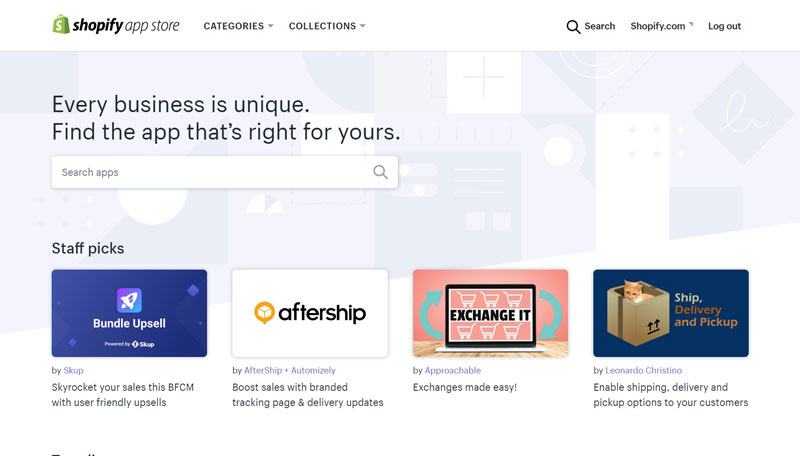
Squarespace
To access all of the features that Squarespace offers, you do need to be on the Advanced Commerce plan and the Business and Basic Commerce plans are a little light when it comes to features, which is why we have summarised all of the features that are available on Squarespace:
Ecommerce Tools
- Sell Physical, Digital, Service based products
- Custom Forms
- Product Quick View
- Limited Availability Labels
- Product Variations
- Gift Cards
Marketing & SEO
- Built-in Blog
- Abandoned Cart Recovery
- Discounts
- Sell on Instagram
- Product Reviews
- Email Campaigns
- Social Media Integration
Reporting
- Revenue
- Units Sold
- Number of Orders
- Conversion Rate
- Average Order Value
- Revenue per Visit
Payment Gateways
- PayPal
- Stripe
- Afterpay
- Square (for POS)
Squarespace Extensions
Squarespace also offers a range of extensions that allow integrations with third-party platforms, such as:
- Printful
- Xero
- Quickbooks
- Shipstation
But the selection is significantly smaller than what is offered through Shopify and many of the integrations are paid for.

Website Builder
Shopify
Shopify has arguably the best website builder of all the ecommerce platforms that are currently available, this is because:
- There is a huge number of themes to choose from
- They offer a full-site customizer
When it comes to theme selection, there are over 100 free and paid-for themes that are available directly through the Shopify theme store and thousands available through marketplaces such as ThemeForest or directly from developers.
Where Shopify really shines though is the customizer as it allows you to build custom pages using a selection of blocks, of which there are a good selection as standard and there are plenty of design options for each block type.
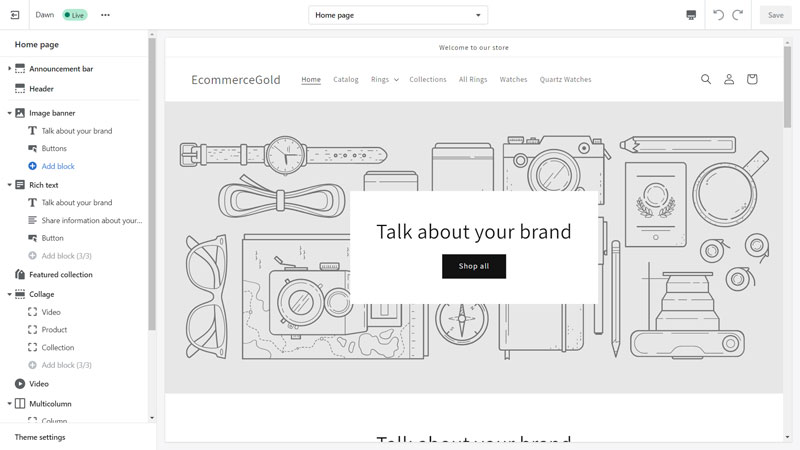
There are also site-wide options to set custom fonts and colors along with options for your site’s header and footer.
Outside of the customizer, you do get access to the theme’s code and this enables another level of customization, especially for people who understand or a prepared to learn Shopify’s liquid code.
The only area where Shopify struggles when it comes to customization is blog posts as you are limited to a pretty basic text editor and if you want to create custom blog posts using different sections, then you need to install a page builder app.
Squarespace
Squarespace isn’t far behind Shopify when it comes to its website builder and they are true to their word when they say that it is easy to build a good-looking website using Squarespace.
One big change that Squarespace made recently was to basically scrap their theme selection and instead use a core template that can be easily customized using the selection of sections and content blocks that are available in the customizer.
You can start with a pre-built design but unfortunately can’t switch to any other designs, instead you have to customize your existing design to match the one you like.
As with Shopify, there are also some site-wide options that includes fonts and colors.
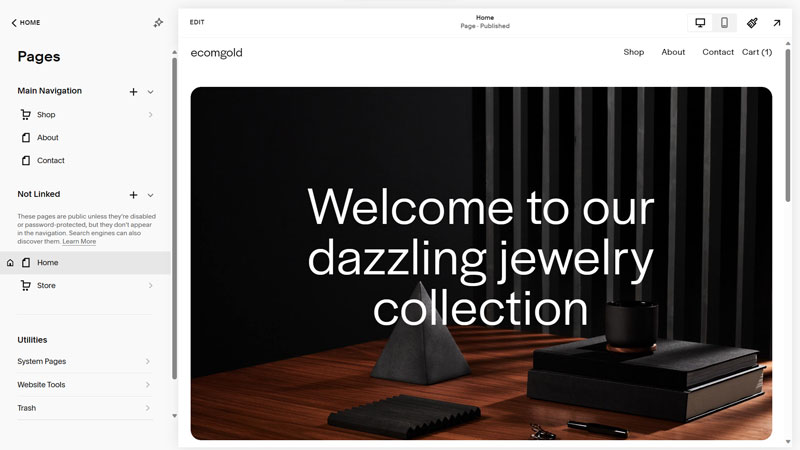
The Squarespace website builder is one of the few that can compete with Shopify in terms of customization being easy to do as the workflow for customizing your site works really well but there is more you can do in terms of customization in Shopify and you get access to the theme code, which you don’t get with Squarespace.
The one thing Squarespace does do better is when it comes to creating blog posts as you can use all of the sections and blocks to create truly custom posts.
Support
One of the reasons why people choose a hosted platform such as Shopify or Squarespace is that they get help and support to run their website. But how good is either platforms offering?
Shopify
Shopify made some changes to their customer support in 2023, with an overhaul of the help center and all support moving to live chat (with the help of an AI chatbot) and email.
This has made contacting their support easier and it is available 24/7, you just have to figure out how to get past the chatbot so that you can speak to a human operator.
They also offer a community support forum, which can be a great place to find information and also ask non-urgent questions as it is frequented by many Shopify support team members and Shopify partners.
Squarespace
Squarespace also offers 24/7 support but this is only available via email.
The do offer live chat support but this is only available 4 am – 8 pm EST, Monday to Friday and they don’t offer any phone support.
Hosting & Performance
Shopify and Squarespace take very different approaches when it comes to advertising their hosting information. Shopify is very upfront and provides the following information:
- Unlimited Bandwidth
- Unlimited Storage
- PCI Compliant Servers
- Free SSL Certificate
- 99.98% Uptime
- Blazing Fast Servers
Whereas Squarespace are quite secretive and I couldn’t find much information but what I did find (after quite a lot of digging!) was that they offer:
- Unlimited Bandwidth
- Unlimited Storage
- Free SSL Certificate
- PCI Compliant Servers
But this doesn’t stop use from putting both platforms to the test!
And we did just that by taking 5 customer example sites and running them through Uptrends Speed Tool, using the New York server to check both Desktop and Mobile performance on both load time and Google PageSpeed Scores.
We ran these tests once a day for 5 days to get a good spread of data and you can see the results below:

Mobile:
Desktop:

Mobile:
Desktop:
Shopify and Squarespace are very evenly matched when it comes to performance as Squarespace are quicker in terms of load time but Shopify scored better on Google PageSpeed.
If you want to see where both platforms came in my performance leader board then check out our Fastest Ecommerce Platforms post.
Ease of Use
Now I do know that ease of use is subjective to the person using the site so the following is just my opinion and should only be used as a guide.
Getting Started
Shopify
Getting started with Shopify is a very simple process as you only need an email address and to create a password in order to get access to the platform (you will need to upgrade to a paid plan to process live orders).
During the sign-up process, you will be asked a few questions regarding your business as this helps them tailor the platform in some ways so that it fits your business’s needs.
Once you have completed the sign-up process, you will be taken through to your admin dashboard and you will be greeted by a short setup guide, which is a little bit light on steps and could be more comprehensive.

This isn’t really helpful to people who are new to the platform but outside of the setup guide, the admin dashboard is very well laid out and easy to use.
The main sidebar navigation menu is clearly labeled and not overcrowded, making it very easy to navigate from one section to another.
One thing that makes the Shopify admin dashboard nice to use is that they have kept it simple and not overcrowded their pages, which makes it easier to work on and also process any information that you are being provided with, such as analytics.
Squarespace
Getting started with Squarespace is also very simple as you only need an email address and to create a password.
You will then be taken through the onboarding process, which includes some questions about the type of site you are creating, what type of products you will be selling and if you want to choose a pre-built design or do your own from scratch.
Once you have completed this, you will be taken through to your admin dashboard and initially it doesn’t seem like there is much help to get you started but if you click on the selling heading in the sidebar, you will be taken to a short setup guide to help you get your store configured.
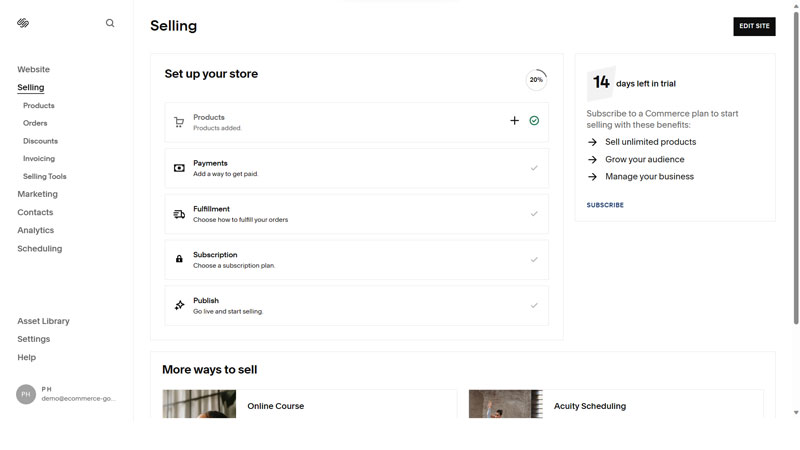
The Squarespace dashboard is very well-designed and easy to use, this is mainly down to the sidebar navigation menu being well-labeled and easy to navigate, with any options not labeled being available in the settings such as payment and shipping options.
Both Squarespace and Shopify have done a really good job with their dashboards as they are both very user-friendly.
Adding and Managing Stock
Being able to manage your stock efficiently and effectively is a hugely important part of running an online store and there are three main areas to this, which are:
- Adding products
- Organizing your Products
- Managing your inventory
Shopify
The simplicity of the admin dashboard carries over to the product page as Shopify has opted for a single-page layout and kept it to the minimum number of sections required in order to add all the information you need for your product.
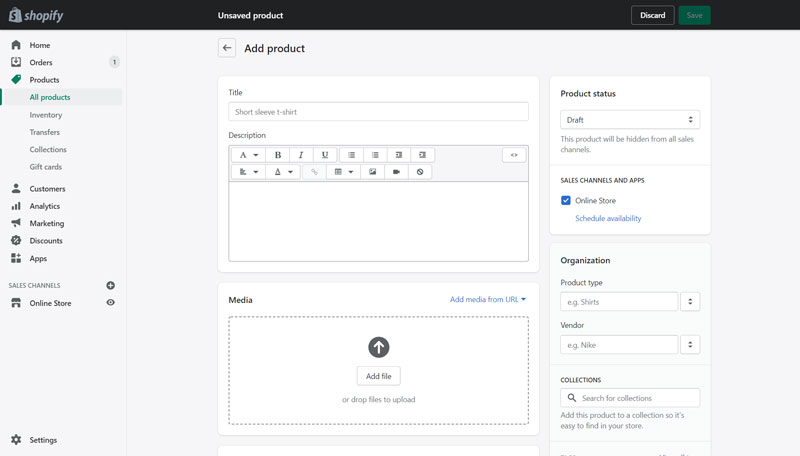
Organizing your products is not so straightforward with Shopify as they have created their own unique collections system, which does have some advantages and disadvantages.
This is because there are two ways you can create collections:
- Manual Collections – which is where you manually add products to the collection
- Automated Collections – where products are added to collections based on rules that you create
This means that Automated Collections do have a steeper learning circle but can be very effective when set up correctly but the big downside of the collections system is the lack of subcollections, which makes creating an effective product hierarchy quite difficult.
Managing your inventory is very simple to do as Shopify has a couple of bulk editors that allow users to quickly update stock levels along with being able to edit many other aspects of your product page using the filter system.
Squarespace
One thing that is very noticeable with Squarespace is the number of different product types that you can sell when it comes to adding a new product, this is because when you click to add a new product, you are presented with eight different options.
And the add new product page is slightly different for all of these product types, for example, when adding a physical product there are fulfillment (shipping) options and for digital downloads there is a field for uploading your file.
The design of the add new product pages are very well done and easy to use with a good workflow between all the different sections and it is all done on a single page.

Organizing your products isn’t quite as good as the category system feels like a bit of an afterthought as there isn’t an option to manage your categories from the main navigation menu, they have to be done through the product add/edit page or through the website customizer, which isn’t ideal.
Squarespace also doesn’t have the option to create sub-categories, which makes creating a product hierarchy a bit difficult.
When it comes to managing your inventory, Squarespace has one of the best systems we have come across as you can update titles, prices and stock quantity directly from the product overview page, which removes the need for a separate bulk editor and this can save a lot of time when it comes to inventory management.
Another nice inventory management feature is that all of the product types are listed under different tabs, which makes finding your products a lot easier than a single list of all of your products.
Managing Orders
Shopify is a little limited when it comes to order management but does offer the ability to:
- Update order statuses in bulk
- Edit orders individually
- Print packing slips
- Export orders
If you want to print order invoices, then you will need to install an app.
Squarespace has made order management very simple as you can easily:
- Print invoices
- Update order statuses
- Export orders
This can be done to orders in bulk or individual orders, which makes order management very easy to do with Squarespace.
Summary
Shopify Summary
Shopify Pros
• Theme Customisation
• 24/7 Support
• Easy to use Admin Area
• The App Store
• Very Good Performance
Shopify Cons
• Transaction Fees
• Automatic Collection system is a bit complicated
• No option to bulk print invoices
Squarespace Summary
Squarespace Pros
• Easy to use
• Good website builder
• Good features
• Sell different product types
• Pricing
Squarespace Cons
• Limited payment gateways
• lack 0f sub-categories
• Can’t change between pre-built templates
Conclusion
Shopify vs Squarespace – Which one is better for an Ecommerce Website?
Even though both platforms are very good options, Shopify does just come out on top for a couple of reasons, including:
- It is purposely designed for building ecommerce websites
- It offers more features as standard and a much larger selection of additional features and integrations via the app store
- They offer 24/7 support via different contact channels
- It feels more scalable as it is built for ecommerce stores of all sizes
Shopify just offers a better overall package for ecommerce websites but Squarespace is still a great option for small businesses and it is one of highest rated options we have tested.

EcommerceGold Score


EcommerceGold Score
Other Comparisons
Hi, I'm Paul, the Owner and Founder of EcommerceGold.
I ran my own Ecommerce Business for over 7 years and now help others start their own online retail empires!

